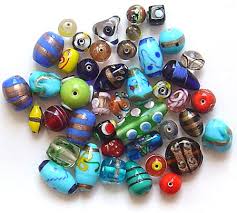bead
英 [biːd]
美 [bid]
- n. 珠子;滴;念珠
- vi. 形成珠状,起泡
- vt. 用珠装饰;使成串珠状
CET6+ TEM4 IELTS TOEFL CET6
1. 该词是bid的变体,表示:(祈祷时用的)珠子。
2. bid本来就含有:祈求、祝愿、祝福之意。
bead 珠子词源同bid, 要求,祈祷,原指祈祷用的念珠。
- bead
- bead: [13] The word bead originally meant ‘prayer’. It comes ultimately from Germanic *beth-, source also of English bid. This passed into Old English as gebed, which by the 13th century had lost its prefix to become bede. (German has the parallel gebet ‘prayer’.) The modern sense ‘small pierced decorative ball’ developed in the 14th century, from the use of a string of rosary beads for counting while saying one’s prayers.
=> bid - bead (n.)
- mid-14c., bede "prayer bead," from Old English gebed "prayer," with intensive or collective prefix *ge- + Proto-Germanic *bidam "entreaty" (cognates: Middle Dutch bede, Old High German beta, German bitte, Gothic bida "prayer, request"), from PIE *gwhedh- "to ask, pray."
Shift in meaning came via beads threaded on a string to count prayers, and in phrases like to bid one's beads, to count one's beads. German cognate Bitte is the usual word for conversational request "please." Also related to bid (Old English biddan) and Gothic bidjan "to ask, pray." Sense transferred to "drop of liquid" 1590s; to "small knob forming front sight of a gun" 1831 (Kentucky slang); hence draw a bead on "take aim at," 1841, U.S. colloquial. - bead (v.)
- 1570s, "to adorn with beads," from bead (n.). Meaning "to string like beads" is from 1883. Related: Beaded; beading.
- 1. Her bead necklaces and bracelets jangled as she walked.
- 她的珠子项链和手镯在她走动时叮当作响。
来自柯林斯例句
- 2. Bead-work, applique and embroidery add a uniquely feminine touch.
- 珠饰、嵌花和刺绣可增添一种独特的女人味。
来自柯林斯例句
- 3. She accidentally swallowed a glass bead.
- 她不小心吞下了一颗玻璃珠.
来自《简明英汉词典》
- 4. The bead is put on the forehead of the dead shepherd ahead of the herd.
- 珠子被戴在畜群前面的死牧羊人的前额上。
来自辞典例句
- 5. Glass bead gels need not be hydrated prior to use.
- 玻璃珠凝胶在使用之前不需要水化.
来自辞典例句
[ bead 造句 ]
